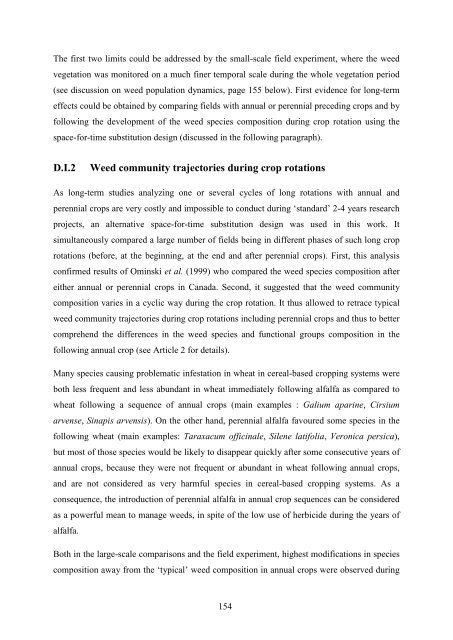Diversifying crop rotations with temporary grasslands - Université de ...
Diversifying crop rotations with temporary grasslands - Université de ...
Diversifying crop rotations with temporary grasslands - Université de ...
Create successful ePaper yourself
Turn your PDF publications into a flip-book with our unique Google optimized e-Paper software.
The first two limits could be addressed by the small-scale field experiment, where the weed<br />
vegetation was monitored on a much finer temporal scale during the whole vegetation period<br />
(see discussion on weed population dynamics, page 155 below). First evi<strong>de</strong>nce for long-term<br />
effects could be obtained by comparing fields <strong>with</strong> annual or perennial preceding <strong>crop</strong>s and by<br />
following the <strong>de</strong>velopment of the weed species composition during <strong>crop</strong> rotation using the<br />
space-for-time substitution <strong>de</strong>sign (discussed in the following paragraph).<br />
D.I.2 Weed community trajectories during <strong>crop</strong> <strong>rotations</strong><br />
As long-term studies analyzing one or several cycles of long <strong>rotations</strong> <strong>with</strong> annual and<br />
perennial <strong>crop</strong>s are very costly and impossible to conduct during ‘standard’ 2-4 years research<br />
projects, an alternative space-for-time substitution <strong>de</strong>sign was used in this work. It<br />
simultaneously compared a large number of fields being in different phases of such long <strong>crop</strong><br />
<strong>rotations</strong> (before, at the beginning, at the end and after perennial <strong>crop</strong>s). First, this analysis<br />
confirmed results of Ominski et al. (1999) who compared the weed species composition after<br />
either annual or perennial <strong>crop</strong>s in Canada. Second, it suggested that the weed community<br />
composition varies in a cyclic way during the <strong>crop</strong> rotation. It thus allowed to retrace typical<br />
weed community trajectories during <strong>crop</strong> <strong>rotations</strong> including perennial <strong>crop</strong>s and thus to better<br />
comprehend the differences in the weed species and functional groups composition in the<br />
following annual <strong>crop</strong> (see Article 2 for <strong>de</strong>tails).<br />
Many species causing problematic infestation in wheat in cereal-based <strong>crop</strong>ping systems were<br />
both less frequent and less abundant in wheat immediately following alfalfa as compared to<br />
wheat following a sequence of annual <strong>crop</strong>s (main examples : Galium aparine, Cirsium<br />
arvense, Sinapis arvensis). On the other hand, perennial alfalfa favoured some species in the<br />
following wheat (main examples: Taraxacum officinale, Silene latifolia, Veronica persica),<br />
but most of those species would be likely to disappear quickly after some consecutive years of<br />
annual <strong>crop</strong>s, because they were not frequent or abundant in wheat following annual <strong>crop</strong>s,<br />
and are not consi<strong>de</strong>red as very harmful species in cereal-based <strong>crop</strong>ping systems. As a<br />
consequence, the introduction of perennial alfalfa in annual <strong>crop</strong> sequences can be consi<strong>de</strong>red<br />
as a powerful mean to manage weeds, in spite of the low use of herbici<strong>de</strong> during the years of<br />
alfalfa.<br />
Both in the large-scale comparisons and the field experiment, highest modifications in species<br />
composition away from the ‘typical’ weed composition in annual <strong>crop</strong>s were observed during<br />
154

















